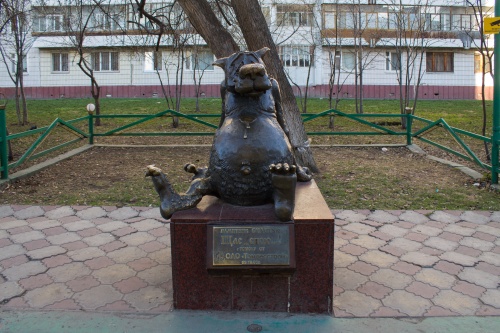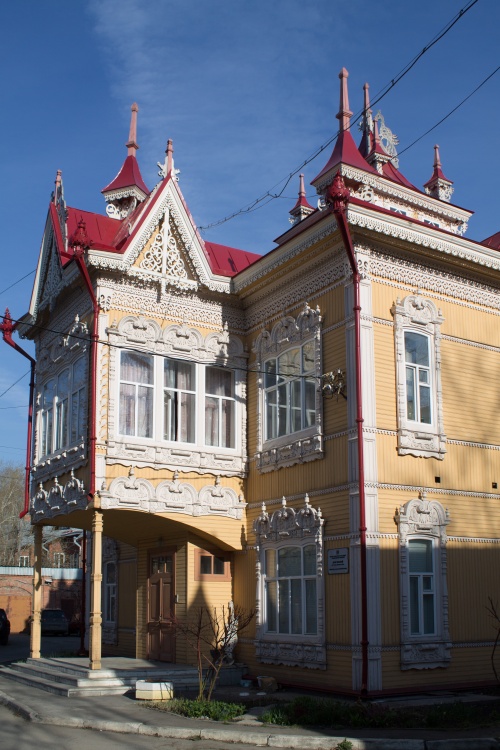Выборка записей по тегу "дворы"

27. Памятник счастью / Monument to the happiness
Памятник счастью был установлен 5 октября 2005 года по инициативе ОАО "Томлесстрой" в качестве подарка городу в честь его 400-летия. Автором идеи называют пресс-секретаря компании Анатолия Захарова. Непосредственную работу выполняли скульптор Юлия Завьялова, литейщик Максим Петров и художник-консультант Леонтий Усов. Памятник, изображающий Волка из культового советского мультфильма "Жил-был пёс...", необычен ещё и тем, что его брюхо напичкано электроникой, и при нажатии расположенной на животе кнопки он голосом Джигарханяна произносит одну из восьми знаменитых мультцитат (например, ту самую "Щас спою..." или "Ты заходи, если что"). С прискорбием стоит отметить, что уже через месяц после установки памятника кто-то украл всю его "электронную начинку". Впрочем, благодаря усилиям местных властей, её быстро восстановили, а за памятником установили видеонаблюдение. Из-за этой характерной особенности памятника с ним связана малораспространённая байка: якобы через некоторое время после установки памятники вечерком к нему прислонился подвыпивший мужичок, а разговорчивый Волк внезапно попросил оставить ему покурить. Судя по всему, ноги этой байки растут из грандиозных (но нереализованных) планов сделать фразы Волка контекстно-интерактивными.
The monument to happiness was installed on October 5, 2005 on the initiative of OJSC "Tomlesstroy" as a gift to the town in honor of its 400th anniversary. The press secretary of company Anatoly Zakharov is called as the author of the idea. Direct work was done by sculptor Yulia Zavyalova, foundry Maxim Petrov and artist-consultant Leonty Usov. The monument depicting the Wolf from the cult Soviet cartoon "Once upon a time there was a dog ..." is unusual also because his belly is stuffed with electronics, and when the button on the stomach is pressed, he pronounces one of the eight famous citates from cartoon (for example, the same one "Right now I'll sing ..." or "You come in, in the case"). Sadly, it is need noting that one month after the installation of the monument, someone stole his entire "electronic stuffing". However, thanks to the efforts of local authorities, it was quickly restored, and video surveillance was installed behind the monument. With this characteristic feature of the monument is associated a little-spread fable: ostensibly some time after installation of the monument, in the evening, a drunk man leaned against him, and the talkative Wolf suddenly asked to leave him a cigarette. Apparently, the legs of this fable grow from grand (but unrealized) plans to make Wolf phrases contextually-interactive.

30. Флигель купеческой усадьбы Л. Д. Желябо / The outbuilding of the merchant's estate of L. D. Zhelyabo
Дом по адресу "улица Красноармейская, 67/1" - это едва ли не самый яркий памятник деревянного зодчества в Томске. Он был построен в 1903 году во внутреннем дворе усадьбы купца Леонтия Желябо по проекту главного архитектора Томска Петра Федоровского (который сам по себе - личность примечательная, закончил Петербургскую академию художеств, обучался у известного русского художника Александра Бенуа). Постановлением Совета Министров РСФСР №624 от 4 декабря 1974 года дом был включен в список архитектурных памятников федерального значения.
The house at "Krasnoarmeyskaya (Red Army) street, 67/1" maybe is the most outstanding monument of wooden architecture in Tomsk. It was built in 1903 in the courtyard of the estate of merchant Leonty Zhelyabo by the project of the chief architect of Tomsk, Petr (Peter) Fedorovsky (who itself is a remarkable person, graduated from the St. Petersburg Academy of Arts, studied with the famous Russian artist Alexander Benois). By Decree of the Council of Ministers of the RUFSR No. 624 of December 4, 1974 the house was included in the list of architectural monuments of federal significance.

31. Дом с жар-птицами / House with fire birds
Помимо этого дома, известного в Томске и как "дом с жар-птицами", в состав ансамбля усадьбы Леонтия Желябо входило ещё три дома. И у каждого из этих домов - сложная судьба. Из четырёх строений лишь тот самый "дом с жар-птицами" сохранил свою аутентичность до наших дней, ещё два здания усадьбы представляют собой реконструкции на месте старых зданий, осуществлённые в 80-е годы по программе "Старый Томск", но больше всего не повезло зданию по адресу "улица Красноармейская, 65/1" - сначала пришедший в полную негодность дом был расселён, затем земельный участок под ним был продан на аукционе, а в итоге на месте деревянного домика был выстроен бетонный новодел, обшитый тесом. Городская администрация планировала через суд добиться сноса новостройки и восстановления архитектурного памятника, однако, судя по тому, что дом стоит, как стоял, ничего из этой затеи не вышло. Под угрозой было и существование последнего оригинального здания в ансамбле усадьбы. К 2008 году "дом с жар-птицами" очень серьёзно обветшал после последнего ремонта. Особенно сложная ситуация сложилась с крышей здания, пришедшей практически в полную негодность. Спасли дом лишь старательность и настойчивость его жильцов, внимание общественности и СМИ, а также отвалившийся от потолка во время очередного дождя и чудом никого не прибивший кусок штукатурки. В итоге всё-таки было принято решение о ремонте и реставрации дома, проведённых в два этапа.
In addition to this house, known in Tomsk as a "house with fire birds," the ensemble of the estate of Leonty Zhelyabo included three more houses. And each of these houses had a difficult destiny. Of the four buildings, only that "house with fire birds" has retained its authenticity to our days, two more buildings of the estate are reconstructions on the site of old buildings that were carried out in the 80s under the program "Old Tomsk", but the most sad fate befell to the building at "Krasnoarmeyskaya (Red Army) Street, 65/1" - first of all, the house, that became completely unfitness, was settled out, then the land plot under it was sold at auction, and in the end, a concrete replica was built on the site of the wooden house. The town administration planned through the court to demolish the new building and restore the architectural monument, however, judging by the fact that the house stands as it stood earlier, nothing came of this venture. The existence of the last original building in the ensemble of the estate was also under threat. By 2008, the "house with fire birds" had decayed very seriously after the last repair. Particularly difficult situation arose with the roof of the building, which came almost completely out of order. The house was saved only by the diligence and perseverance of its residents, the attention of the public and the media, and also by a piece of plaster, which fell off the ceiling during the rain and miraculously slamed nobody. As a result, it was finally did a decision about repair and restoration of the house, that were conducted in two stages.


